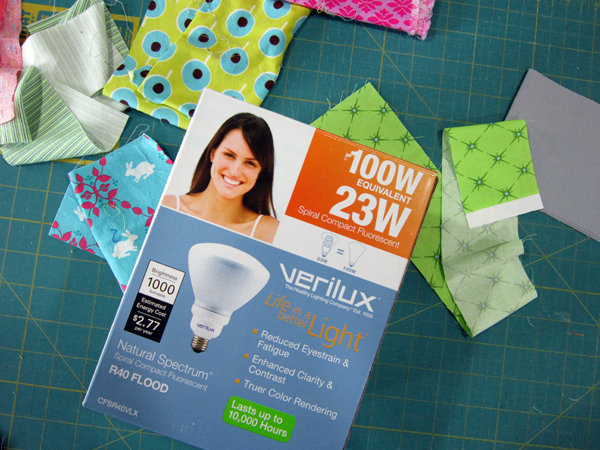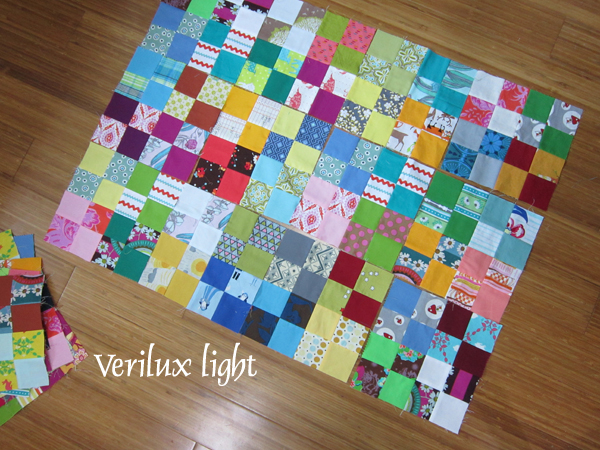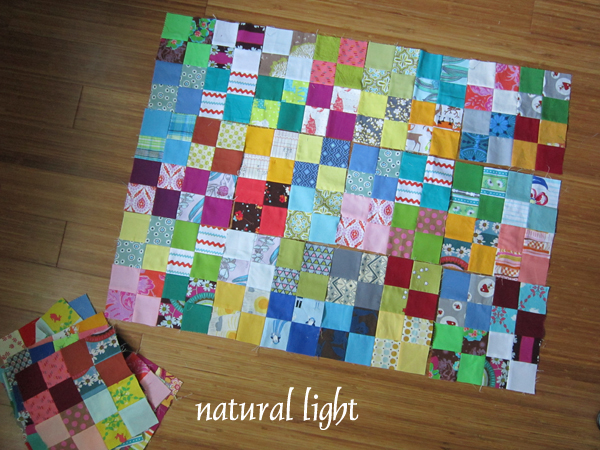on fancy Light bulbs
Months ago I was contacted by a company who wished for me to test and review their light bulbs in my sewing space. Seriously... light bulbs. Usually these type of offers are not a good fit, so I turn them down. But, while light bulbs are not a terribly exciting topic, they are something we use every day.
This is the part of her email that really got my attention, "Research shows (and our consumers know) that our lighting products reduce eye strain/fatigue, allow colors to appear truer than conventional lighting, as well as elevate mood and energy." Hmmm?

I responded, "I hate to use artificial lighting of any kind as it certainly does alter color perception. Unfortunately, on cloudy days it's necessary. It would be wonderful if your lights could help. A few questions:
Is there a large difference between your light technology and light bulbs one buys at hardware stores that are sold as "daylight balanced"? I currently use daylight balanced bulbs by Utilitech in the recessed lighting that is throughout my sewing workroom."
By the way, when I switched to "daylight balanced" bulbs I had noticed an improvement in the way colors appeared under the lights. I still could tell that my color perception was "off" under artificial lighting and would always wait for sunlight to choose fabrics for a project. Also, I tend to keep lights off during the day. I so much prefer natural light patterns and even shadows.
Heather from Verilux responded in detail to my inquiry. In case you are an information junkie like me, I'll copy and paste the details. But, the gist of it is that their lights are indeed more "true" than daylight balanced bulbs:
Daylight-balanced lights generally fall in the 5000/5500K range and ours are closer to 6500K, which is the temperature of actual daylight. That means our light is a bit closer to actual daylight than most "daylight balanced." When light temperature is much lower or higher than daylight, you get color distortion (either of reds or blues).
This picture highlights the difference in how colors appear under typical incandescent vs. Verilux bulbs. In case you don't know, one great way to make a choice for lights you want to use for photography is to check out the CRI (color rendering mix). Verilux bulbs have a CRI of 85. Professional photographers who use supplemental light consider anything 90 or higher acceptable, so we are very close to what is used on photo shoots.
I decided to try Verilux flood lights for my sewing room recessed lighting. There were some hiccups with my shipment(s), as a few bulbs kept getting broken in transit. Since it happened twice in a row, we're thinking my UPS driver may be at fault. Anyhoo, Verilux was happy to replace them, which they would do for any customer. They have a 30 day product guarantee.
So, what do I think? They make a difference. I actually chose fabrics for Tangential at night under my Verilux lighting with total confidence. And, you know that was a pretty important project to me! I can tell that these lights don't distort color. Here's an example:


Neither of these photos have been color corrected in any way. You can see that the colors are virtually identical. The shadows and bright spot reflections created by artificial recessed lights still make them less than ideal for photographs, but the color is a great improvement.
The other difference is that it actually feels good to have the lights on. As I mentioned, I usually prefer to be in dim natural light than fake light. With these bulbs, it's different. I turn on the lights during the day in my sewing room, whether sewing or typing or cutting. They feel so bright and cheerful, almost just like sunshine. I didn't expect to notice or care about that, but I do.
Well, if you have any questions, do let me know. Verilux had a lot of lighting products other than bulbs, so if you need a lamp for desk work or task lighting by a chair you may want to take a look. Hope this has been helpful!
This is the part of her email that really got my attention, "Research shows (and our consumers know) that our lighting products reduce eye strain/fatigue, allow colors to appear truer than conventional lighting, as well as elevate mood and energy." Hmmm?

I responded, "I hate to use artificial lighting of any kind as it certainly does alter color perception. Unfortunately, on cloudy days it's necessary. It would be wonderful if your lights could help. A few questions:
Is there a large difference between your light technology and light bulbs one buys at hardware stores that are sold as "daylight balanced"? I currently use daylight balanced bulbs by Utilitech in the recessed lighting that is throughout my sewing workroom."
By the way, when I switched to "daylight balanced" bulbs I had noticed an improvement in the way colors appeared under the lights. I still could tell that my color perception was "off" under artificial lighting and would always wait for sunlight to choose fabrics for a project. Also, I tend to keep lights off during the day. I so much prefer natural light patterns and even shadows.
Heather from Verilux responded in detail to my inquiry. In case you are an information junkie like me, I'll copy and paste the details. But, the gist of it is that their lights are indeed more "true" than daylight balanced bulbs:
Daylight-balanced lights generally fall in the 5000/5500K range and ours are closer to 6500K, which is the temperature of actual daylight. That means our light is a bit closer to actual daylight than most "daylight balanced." When light temperature is much lower or higher than daylight, you get color distortion (either of reds or blues).
This picture highlights the difference in how colors appear under typical incandescent vs. Verilux bulbs. In case you don't know, one great way to make a choice for lights you want to use for photography is to check out the CRI (color rendering mix). Verilux bulbs have a CRI of 85. Professional photographers who use supplemental light consider anything 90 or higher acceptable, so we are very close to what is used on photo shoots.
I decided to try Verilux flood lights for my sewing room recessed lighting. There were some hiccups with my shipment(s), as a few bulbs kept getting broken in transit. Since it happened twice in a row, we're thinking my UPS driver may be at fault. Anyhoo, Verilux was happy to replace them, which they would do for any customer. They have a 30 day product guarantee.
So, what do I think? They make a difference. I actually chose fabrics for Tangential at night under my Verilux lighting with total confidence. And, you know that was a pretty important project to me! I can tell that these lights don't distort color. Here's an example:


Neither of these photos have been color corrected in any way. You can see that the colors are virtually identical. The shadows and bright spot reflections created by artificial recessed lights still make them less than ideal for photographs, but the color is a great improvement.
The other difference is that it actually feels good to have the lights on. As I mentioned, I usually prefer to be in dim natural light than fake light. With these bulbs, it's different. I turn on the lights during the day in my sewing room, whether sewing or typing or cutting. They feel so bright and cheerful, almost just like sunshine. I didn't expect to notice or care about that, but I do.
Well, if you have any questions, do let me know. Verilux had a lot of lighting products other than bulbs, so if you need a lamp for desk work or task lighting by a chair you may want to take a look. Hope this has been helpful!

